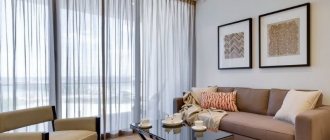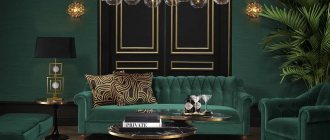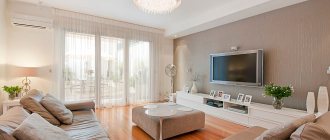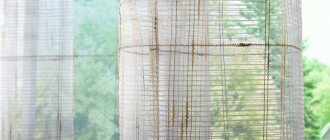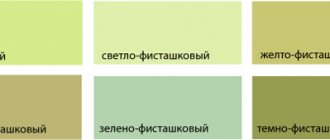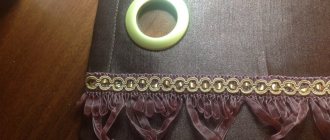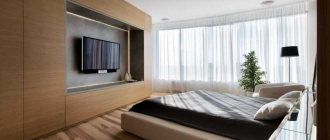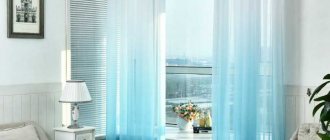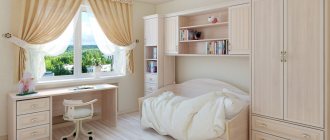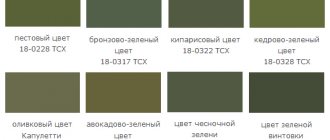Main characteristics of choosing tulle: what to look for
The choice of curtains is based on several factors:
- Depending on the interior style. For example, for the Baroque, minimalism and Renaissance styles, translucent floor-length models are suitable. If the living room is made in a country style, then it is better to choose shortened models. The high-tech style can be effectively complemented by tulle made of shiny textiles with a silver tint.
- Before purchasing, you should measure the window opening in different projections: height, length, width. After receiving this data, you need to double the width. You can choose a canvas based on double width and calculated height.
- Pay attention to the texture. Thick fabrics are always convenient, as they are more practical and cover the window from excess light. If there is no need to hide the room, then you can choose thin tulle. It will be easier to care for.
Living room with fireplace Source remoo.ru/
- In spacious rooms it is better to give preference to dark shades of curtains: brown, ash, black, blue with spectacular drapery. For small rooms, it is better to purchase light models, preferably translucent. These include muslin, veil, and mesh textures of curtains.
- Use a combination of colors. Here you also have to pay attention to the color of the interior. Often, light tones of green, blue, beige, cream or coffee are used for tulle. If a lambrequin is provided for curtains, then it is better to create it from fabrics that are a shade darker. However, strong contrast is not recommended.
- Curtains in a hall or living room should not only be beautiful, but also functional. Make sure that after decorating the window, the curtains are easy to manage. Rope mechanisms can be used for this.
Chic interior Source dekormyhome.ru
In golden tones Source mydizajn.ru/ Modern design with a fireplace Source www.remontbp.com
To purchase tulle for the hall, it is first recommended to complete the renovation and provide for all design features: starting from the main pieces of furniture (upholstered furniture, shelving, false walls) , ending with decor: paintings, figurines, floor flowerpots.
Translucent curtains in a combination of two shades Source stil-no.org
See also: Catalog of companies that specialize in interior redevelopment.
Winter and summer curtains
Today it is very fashionable and relevant to use curtains in accordance with the season. That is, the housewife has a separate set of curtains in stock for both summer and winter. Thanks to this approach, the interior of the house will always correspond to the current season. In this case, there is no need to change the entire set of curtains, but it is enough to change some decorative elements.
In summer, curtains should allow air to pass through perfectly, block bright sunlight, and at the same time not be bulky and create a feeling of lightness. In the summer, you can abandon thick curtains to ensure excellent air circulation, and make do with only thin fabric. It is possible to use tulle of different tones and shades, which will allow you to create a beautiful multi-layer composition.
You may also be interested in: Combination of Roman blinds with drapes and design photos
In winter, on the contrary, care must be taken to ensure sufficient light in the room. After all, even in sunny weather it is cold outside and the rays do not warm up the room as in summer. Therefore, it is better to take care of creating warmth through interior decoration. Curtains in warm colors and with a fleecy structure are perfect for this. Such fabrics include velvet, taffeta or plush.
Curtains made from these materials will help create additional comfort in the room during the cold season. In winter, you can productively use all kinds of tapes and tiebacks. After all, multi-layer curtains in winter give a cozy and warm atmosphere to the house. With the right choice of window design, you can create comfort in your room throughout the year.
Save
Save
Save
Recommended by
How to beautifully hang tulle in the hall: modern trends
Hanging curtains on windows is a very painstaking job. Anyone who has at least some skill in organizing an interior and a sense of taste can cope with it. Previously, all curtains were decorated on windows in a classic way: they hung straight, sometimes even without waves. Now, in order for the decor to correspond to fashion trends, you should use different types of curtain assembly.
Decorating a window with curtains to match the interior Source fb.ru
Curtains with smooth, identical waves on a panoramic window Source takprosto.cc
Tulle with drapery and curtain cover Source smak.ua
Snow-white curtain with translucent texture with night drapes Source jaluzityul.ru
We hang curtains and tulle correctly on curtain tape
If you are planning to hang a curtain or tulle on a curtain tape yourself, then you need to know several very important factors that will determine the final result.
Until recently, the process of hanging new or just washed curtains turned into a real torment, because you need not only to hang, but also to drape the fabric beautifully, otherwise it will completely lose its aesthetic function. Therefore, I had to suffer quite a bit, calculating the necessary intervals and fixing the curtains.
But with the advent of curtain tape, this process has become much simpler, because this accessory allows you to completely prepare the canvas; all that remains is to simply put it on the curtain rod. In order to save yourself from unnecessary hassle and forever forget about standing for a long time with your head and arms raised high, we will try to understand the features of the choice in as much detail as possible, and will also tell you how to hang curtains on curtain tape.
Wave formation
The most popular and win-win way is to create waves of equal width. They are created on tulle, which is equipped with ribbons for tightening. To form such folds, you need to pull the curtain on both sides and tie ribbons. Then distribute the waves evenly across the entire width of the canvas. Here it is important to carefully ensure that all folds are even. Therefore, do not tighten the curtains too much on the sides. Remember, this tulle gathering effect will only be available if the curtain has a width 2-3 times the length of the cornice.
Classic light tulle Source stoshtor.ru
Multi-module curtain in bundles with laces Source ladyhow.ru Kisey tulle for the living room in combination with a veil Source mydizajn.ru
Beautiful tulle with body waves for a large window Source t-mall.store
Tulle fashion trends
The design industry is developing very rapidly. Various examples of tulle in 2021, which can be seen in photographs of manufacturers, are strikingly different from what was fashionable just a couple of years ago.
And this is normal, the main thing in the pursuit of trends is not to get confused and not to choose the tulle that will not complement your room or will generally spoil the overall atmosphere.
- No wonder they say that fashion is a cyclical thing. Recently, both among professionals and among ordinary buyers, the vintage tulle style has become popular.
- Yes, it doesn't fit every room. If the overall interior is made in high-tech style with modern furniture and accessories, then vintage tulle will clearly look ridiculous.
- But a conventional loft or just a standard room without bright colors may well be complemented by some avant-garde and non-standard solution like vintage tulle.
Tulle in bunches
For large rooms with wide windows, curtains are often collected in bunches. They allow light to better penetrate the room. To do this, you will need a cornice with two channels for curtains. Here it is better to use options that differ slightly in shades: pink and cream; white with coffee. We hang two tulles on each of the cornice strips. Then we create volume in the upper part, and collect the lower part into bunches. For decoration, you can use ribbons or nylon laces with pompoms.
Snow-white curtain for the hall Source cmp24.ru
On a note! Often tulle is not used on its own. It plays the role of a background for the night thick textured curtains.
Color selection
White
Most often, white tulle is used for interiors in its pure form, shades of milky or ivory. It creates a light atmosphere, is suitable for small apartments, leaves the window visible and at the same time frames it well.
Grey
Gray is a neutral color and creates a veil effect. A dark shade is suitable for a large room, and a light one for a small one. The practicality of the color can be seen in the photo.
Black
You need to be careful with black color, for example in combination with white or light finishes on the floor, ceiling or walls, example in the photo.
Brown
Brown in a chocolate shade will be combined with milky curtains. It has a good effect on creating comfort in the apartment.
Beige
Beige and champagne colors are suitable for a multi-colored interior, combined with any shades, making the room bright.
The photo shows French tulle curtains in the hallway. The beige translucent color matches the color of the tile ornament.
Red
Red color attracts attention, creates an accent and does not need to be supplemented. It is important that red tulle resonates with a decorative item, such as a carpet or figurine.
The photo shows an example of a modern interior in red that looks stylish. Light walls and a light gray sofa balance the red and black colors.
Yellow
Yellow is for dimly lit or cool rooms. This tulle is combined with brown, white, and blue curtains.
Orange
Orange, like yellow, will warm the interior and highlight the role of the window in the room. Looks good in the kitchen, living room and bedroom. Emphasizes activity and positive mood.
Gold
Gold, like white, is a classic for tulle. Most suitable for a classic living room and bedroom, combined with white, black, burgundy.
Pink
Pastel pink will highlight the delicacy of a bedroom or nursery; it can be combined with light gray furniture and white wallpaper. Curtains with different shades of pink also look good, as in the photo.
Light blue, blue
Blue and blue tulle will cool a hot room; no need to combine it with dark curtains. The color of the walls can be beige, white, blue, yellow.
Turquoise, green
Turquoise and green relax, put you in the mood for relaxation, and are suitable for the bedroom and living room. Mint shades are refreshing and combine with yellow, red, and white wall colors.
The photo shows an interior where translucent turquoise organza is combined with gray curtains and acts as a bright accent.
Lilac, purple
Lilac and violet will emphasize the dynamism of the interior, which will always look fresh and interesting for guests. Can be with white or black embroidery.
Crossing double sided curtains
Many people prefer translucent tulle with a semicircular side border. Such models can also be beautifully hung. Such curtains on rings look good. We take two halves of identical tulle and hang them on the curtain with approximately equal distances between the waves. Then we collect the lower part of both sides into a bun with a ribbon, and pull the upper part slightly onto the opposite side. We do the same with the second part of the curtain.
Tulle over thick curtains in a dark interior Source shtorlandiya.ru
Beige tulle in the hall with a floral print Source shtora.info
Curtain accessories – how to choose the right one?
Depending on the cornice, curtain fittings are also selected. Tulle is hung on ceiling, profile, and baguette cornices using curtain tape and ordinary hooks:
To hang the tulle on the rod cornice, you will need rings for the hooks. Or you can do without hooks and tape, and use rings with clips or eyelets. The latter option is very popular, but may require thickening the tulle with a special duplicating or finishing fabric:
You can also do without fittings altogether by hanging the tulle on fabric ribbons or loops.
There are a lot of finishing accessories for decorating tulle and curtain compositions in general - they will definitely help you choose all this in the store, it is only important to clearly understand the “design project”.
Tulle over curtains
In modern interior styles you can often find extraordinary window designs. For example, openings where thick curtains are considered basic and tulle is considered additional. For this design, you first need to hang curtains on the cornices, and then two pieces of tulle. Thick curtains are hung to form voluminous folds, and thin curtains on top of them are gathered into a bun in the middle. But you can save money on this type of window decoration if you order tulle with curtains two in one. Such curtains are usually sewn together. They are purchased for such design trends as modern, modern, high-tech.
Burgundy chiffon for a large window in the hall Source qdh.net
Tulle and curtain in one texture without a pattern for spacious rooms Source mydizajn.ru
Types of tulle
Tulle adds spaciousness to a small space, masks an uneven window opening, and creates a play of rays and light. Textile production offers a large selection of tulle textures, which can be divided into smooth, openwork and mesh.
- Standard tulle without large patterns can be made of cotton or organza. It is distinguished by its simplicity of design and the ability to be used with curtains. It is better to wash it by hand, after soaking it, without twisting, with a gentle squeeze. Ironing should be done on a delicate cycle through a cloth or damp gauze.
The photo shows beige plain tulle, which in a light shade matches the interior without a pronounced emphasis on a specific color.
- The mesh differs in the size of the cells and is the background for the curtains. Can be made from thin or thick weave threads. It is not recommended to use it yourself, since such tulle does not protect the room from the sun.
- Tulle with embroidery is often seen in photos in interiors. Embroidery can be of any size, for which metallized or silk threads are used. Complex patterns, gold monograms on a cream background are suitable for classics, floral colored embroidery is suitable for country style, and for minimalism and modern style it is better to use embroidery with lines and simple geometry. Embroidered patterns can be simple and elegant, as in the photo example.
- Tulle comes in vertical or horizontal stripes, which correct the perception of space, making it taller or wider. Narrow or wide stripes can be single or combined. The stripes can be inserted satin or embroidered.
The photo shows tulle with horizontal large and small stripes, which make the space wider and the interior interesting.
- The web consists of weaves of silk and synthetic threads, looks weightless, but at the same time is quite durable and does not require ironing. The web can have embroidery; it can be used either independently or in combination with curtains.
- Kisey, noodle or thread curtains can be of different densities, with or without bead decoration. They shade the room well, drape easily, do not wrinkle, and are convenient for decorating a door to a loggia. Suitable for modern interiors and used as a partition for different zones within the same room. They can also be combined with blinds, as in the photo.
- The design on the tulle can be embroidered, embossed, or sewn. Jacquard pattern, curls, tulle with flowers are suitable for a classic style. Geometry and lines look good against the background of neutral curtains in a modern interior. The pattern can repeat the wallpaper pattern, as in the photo.
- Tulle rain is so called because of the dense thread woven into a plain fabric that resembles rain. It attracts attention, but at the same time remains neutral, suitable for a busy interior where you need to calm the general background. It can be one color, with a vertical or horizontal gradient.
- Floral tulle is suitable for country and Provence style. The size of the floral ornament should not conflict with the size of the tulle. Bright flowers look good against a neutral wall background; lush drapery is inappropriate because the design will be invisible.
The photo shows a bedroom in a modern style, where the floral pattern is the object of attraction. Embroidery with beige threads on light organza looks modest and at the same time luxurious.
- Lace tulle is most often used for the interior of the bedroom, terrace and living room. The openwork on the veil can be sewn, embroidered or bobbin. The fabric can be completely lace or with inserts. They create comfort, let in light and protect from prying eyes.
- Pleated tulle is similar to a reaper, it can be used independently, does not wrinkle, and has high plasticity. It allows light to pass through but blocks the sun's rays, making it suitable for south-facing windows.
The photo shows curtains with grommets in the nursery. The bright transitional color fills the room with rich colors.
Tulle for a living room in a Scandinavian style
When choosing curtains for windows in a living room (hall), decorated in a Scandinavian style, it is necessary to take into account factors such as artificial and natural lighting. At the same time, give preference only to natural fabrics: silk, satin, cotton, linen. In terms of colors, it is better to give preference to models in light colors: beige, blue, light green, pale pink, cream or white.
Tulle for the floor with an interesting combination Source tmali.ru
Light curtains for the living room and dining room Source chinasalesbay.ru
Gray tulle on eyelets for a large window Source alifish.ru
As for the pattern on the curtains, it is used only in extreme cases to defuse the situation. For this purpose, window textiles with geometric lines are purchased. Fabrics are not allowed to have elegant, delicate shapes. In order not to make a mistake, it is better to give preference to plain tulles.
Tulle - what kind of fabric?
Today, the concept of “window tulle” combines textile curtain products made from different fabrics, differing in the degree of transparency and rigidity. Let's look at the most popular types.
Veil
Natural material made from cotton, linen and silk fibers. Voile tulle has the following advantages:
- very soft and pliable, so it is easy to form neat folds from it;
- quite dense and does not transmit daylight well. You can use such curtains without curtains, thereby creating a feeling of airiness and lightness in the room;
- practically does not attract dust and is very easy to wash.
A wide selection of shades allows you to choose the right option for an interior designed in any color scheme. An excellent solution for a nursery or bedroom.
Organza
A favorite material of designers, which has the following advantages:
- holds its shape perfectly and does not wrinkle at all;
- diffuses street light well;
- does not collect dust;
- does not absorb odors;
- has high strength;
- organza curtains tolerate machine washing well and dry quickly.
Such tulle
Can be
hung
in the living room, kitchen, hall. Today we offer a huge selection of plain and patterned models. The fabric is often decorated with the effects of a chameleon, broken glass, rainbow, gradient, etc. A window decorated with organza will look elegant and solemn.
Net
An original solution that will organically fit into an interior designed in the spirit of loft, country or minimalism. Mesh tulle
It is better
to hang
together with curtains made of coarse fabrics of the same shade. This material is rarely used as an independent decorative element. The mesh is practically unable to block daylight. Ideal for rooms with windows facing north or west. Manufacturers offer large and fine mesh models made from dense threads and even laces.
Gas
Made from silk, viscose or polyester. It is distinguished by its special airiness due to a special production technology, which leaves free space between the warp and weft fibers. Textile stores offer matte, semi-matte, patterned and printed products.
It is better to hang tulle made of mixed and polyester materials on the side facing the sun. The fact is that natural textiles made of silk and cotton tend to fade when exposed to direct sunlight. In addition, it shrinks after washing. Synthetic curtains are resistant to fading, retain their shape well and in most cases do not require ironing.
Interesting fact!
The word “tulle” has French roots. In the town of the same name in France in the 15th century, this type of fabric was first invented. As the story goes, it was at this time that the king issued a decree in which weavers were required to come up with a fabric that could hide a person, but at the same time provide him with good visibility of what was happening.
Thin curtains in a classic style
The classic style of curtains is considered the most popular among different types of decoration. To create a neat atmosphere in the room, you can use specially tailored curtains in a classic style. You can create the effect of wealth and perfection with your own hands by properly decorating the curtains with drapery, wide rope laces, ruffles and fringe.
Curtains with an interesting design of the bottom edge in a classic style Source cozyblog.ru
Transparent white curtain and thick drapery with a bunch of gathers Source art-interior.moscow
Combination of blinds and tulle on windows in a classic style Source yellowhome.ru
When choosing curtains in a classic style, you need to give preference to textures such as silk, taffeta, brocade, and satin. In this interior direction, curtains look stylish, rich and unique. You can dilute the tulle with nightcloths with a golden tint.
Tulle for the bedroom
As for the bedroom, the situation is diametrically opposite; comfort should always reign in bedrooms. It is not for nothing that this room is considered the center of the family hearth. Here you should stick to muted colors. Plain burgundy, black, dark blue, bronze tulles are ideal for almost any bedroom and will create a fairly pleasant atmosphere.
Art Nouveau tulle
Art Nouveau curtains are a combination of simplicity and lightness. Despite such features, tulle may contain chaotic patterns and ornaments. Chaos of lines and harmony of different shades are welcomed. As for colors, there are absolutely no restrictions for such tulles. To emphasize the features of the interior, textiles are casually attached to the cornice, and the curtains are slightly tilted to the side.
Plain transparent tulle modern Source decoredo.com
Colorful Art Nouveau eyelet curtains Source genuinefootball.casa
If necessary, use wide satin ribbons or laces with rope fiber to secure the bun.
Features of tulle design
This may seem like a very contradictory statement, but tulle is one of the most difficult home design accessories to design. There are many different variations, colors, styles. New tulle items in 2021 are appearing at incredible speed. It is not necessary to understand everything meticulously, but you should have a general idea so as not to make a mistake and choose exactly the model that will ideally complement your home.
The following classification of tulle is generally accepted, from which you can already build:
- By lenght
- By material
- By color
In terms of length, the choice is more than obvious. The vast majority of buyers choose tulle that stretches all the way to the floor.
Indeed, this option can be called universal, as it fits almost every room. Regardless of the color and design of the rest of your room, a plain long tulle is the way to go.
Even if you purchased tulle that is a few centimeters higher and there is a small gap from the floor, this will not spoil the overall picture. On the contrary, some time ago it was a very popular solution among buyers.
If you want to add more coziness and romance to the interior of the room, then you can take tulle with a small excess of fabric to form a fold near the floor. It looks graceful and aesthetically pleasing.
As for the material, the choice here is also small. Modern manufacturers of such products most often use silk. For some, this may seem like too much of an unprofitable pleasure, but this judgment is erroneous. Yes, the price of silk tulle can reach very impressive figures, but the buyer receives an extremely high-quality product that is easy to care for.
- Color is that component of tulle in which no advice is needed.
- Everyone has the right to choose the color that will be pleasing to their eyes.
- The main thing to remember is to combine the color of the tulle with the overall shade of the interior in your room.
- A rash decision would be to purchase dark tulle for a flashy and bright room, and vice versa.
If the buyer has little experience in design and is not well versed in color combinations, then you can look at photographs of new tulle products in different rooms. There is always an example that will suit you and help you make the right choice.
Curtain for the window in the living room in country style
To match the country interior style, you can choose several curtain options for the living room. The main and additional options are often used. Among these are Roman or roll models, which are placed directly inside the window opening. As a rule, such models take up little space.
Beige tulle with a floral motif for a country style hall Source shtora.info Kitchen-living room Source designstil.info
Additionally, the window in the hall is decorated with tulle that goes down to the floor. When choosing, you should give preference to fabrics such as cotton, linen or organza. As for the shade, it all depends on the lighting of the room. Most owners tend to purchase models in light colors: blue, pink, cream. You can dilute the country interior by hanging curtains with an upturn, having smooth patterns, prints with florists in unusual shapes.
Choosing a method for fixing tulle
Having finally decided on the option of curtains, you should think about their fastening. The overall appearance of the composition and the entire interior will largely depend on this. How to hang tulle
so that it is convenient and aesthetically pleasing?
To begin with, it’s worth pointing out that you can attach the fabric sheet not only to the cornice. There are alternative solutions. For example, if the wall material cannot withstand loads and crumbles during drilling, metal (plastic) hooks are used. Several pieces of fittings are installed above the window opening with the same spacing. And you can hang tulle on them using loops or rings. The same approach is appropriate when decorating arched windows. It turns out very aesthetically pleasing, original, and most importantly – practical.
If the choice is made in favor of cornices, you should first of all pay attention to universal models.
Curtain rod holders
String cornices
Hang tulle on them
you can use:
- rings;
- eyelets;
- loops;
- hooks;
- magnets;
- drawstrings.
Also often used for these purposes are baguettes and ceiling profiles. It all depends on the style of the interior and personal preferences. Manufacturers offer fasteners of various shapes, colors and sizes, made of metal, plastic and wood.
Provence curtains
Tulle for a Provence style hall is traditionally chosen with a floral motif. Natural fabrics are also preferable: cotton, satin, silk, organza, muslin. Neat tulles with a moderate pattern over the entire area are what is needed in the declared interior direction.
Transparent curtains for the hall framed with drapes Source shtora63.ru Curtains and blackout curtains in Provence style with flowers Source roomester.ru
Curtains with flowers in Provence style made of thick fabric Source ikeacover.ru
Tulle over curtains Source ozon.ru
The fastening for such tulle can be anything: on eyelets, using clothespins or a drawstring. But the latter is not always convenient, as it often gets stuck when controlling the curtains.
Simple tulle in a modern interior Source www.remontbp.com
Light tulle in the living room Source www.shtora.info/
Decoration of the bay window area Source shtorydom.ru/
Tulle for the kitchen
There is nothing too complicated in the design of a fashionable kitchen interior; experts recommend sticking to the usual style and hanging bright tulles or even transparent ones in the kitchen rooms.
In 2021, finding such tulles will not be difficult. This should be done to ensure that the kitchen is always filled with light and is pleasant to be in on sunny days.
What and how to hang curtains with tulle
Curtains and tulle are hung on a cornice - a device near the window frame. It is necessary to have an accurate understanding of window design before purchasing a cornice.
Guides
These are cornices with runners for attaching the curtains themselves, tulle, as well as lambrequins, giving the interior additional charm. Curtains should be hung on hooks on such a cornice. It is very important to hang curtains and tulle symmetrically and correctly.
Here's a tip on how to hang them quickly and symmetrically:
- We distribute the same number of curtain rod hooks on each curtain.
- We take one curtain and hook one outer loop on the curtain tape to the outermost measured hooks on the cornice.
- Next, we find the central hook among the allocated number of hooks for one curtain. We hang the curtain on it by the middle loop.
- We have two uniform fabrics on one curtain, hooked on the outer hooks and in the middle. Now we find the middle hook on the cornice and the central loop on one of the formed curtain panels, hook it on. And then we continue to hang the curtain according to the same principle.
- In the same way, you can hang the tulle evenly and correctly, only on a different guide part of the cornice, which is closer to the window itself.
This is a traditional type of cornice. They will fit into any interior. They are made of metal, wood, or plastic. Can be mounted on walls and ceilings. At the ends there are decorative tips of various shapes and configurations. For this type of cornices, rings with hooks and special clothespins are used. Curtains and tulle with holes in the metal edging through which the cornice passes look very original and beautiful.
Roman curtain rod
This is a special cornice with a mechanism for roller curtains.
This version of the cornice is a string stretched between the walls near the window or on the frame itself. Is the most economical way to hang curtains. Curtains can be attached to specially sewn loops, or put on through holes in the curtains themselves. Ideal for light fabrics. Almost invisible and look beautiful on the window. Such cornices will come in handy in the kitchen.
Basic rules from designers
Therefore, if you do most of the repair work yourself, based on your own taste and sense of style, take note of the advice of professional designers to avoid mistakes. So, the main points that are important to choose the right tulle and curtains.
Fabric pattern and color
- Vertical stripes will add height to the room, horizontal stripes will expand the space. Color also carries out a visual transformation of the room: light curtains and curtains with tulle will add space, dark curtains will make the room smaller.
- Windows should not coincide with the surface of the walls and appear to be part of them. Therefore, for light curtains, choose lighter or brighter, contrasting shades, playing with combinations with thick curtains.
- Warm colors (shades of yellow, orange) are suitable for dimly lit rooms: the light in the room “colored” by them will seem filled with warm sun rays. Cold blue, lilac, gray colors will create a feeling of freshness and coolness. To create lightness and elegance, choose curtain fabrics with woven silver threads or glossy, shiny surfaces.
Related article: How to sew curtains with lambrequins with your own hands: patterns and cutting
Warm colors
- In small, low rooms, avoid lambrequins. Although they emphasize the elegance and sophistication of the window decoration, low ceilings will drop even lower.
- The richness and richness of the drapery depends on the texture and density of the fabric. For dense materials (linen, cotton), it is enough to mark shallow folds. But to make light, transparent fabric look attractive, tulle is purchased 2 or even 3 times the length of the cornice.
- New tulles and curtains - muslin. It is used for rooms decorated in any style, it is light and unpretentious in maintenance. With the help of thin threads, many combinations can be created: they can protect the window opening on their own, or be combined with curtains or light curtains. They are hung like tulle over curtains, achieving interesting color and texture effects.
How to combine window decoration with room decoration
There are no universal recommendations for combining tulle or curtains with interior items. It is important to maintain a unified style of the room and not get carried away with monochromatic solutions when the surfaces merge with each other. Win-win combinations:
- The shade of the curtains can repeat the color of a large object or be distributed around the room in the form of small colorful shades: napkins, sofa cushions.
- Don’t try to match the tulle and curtains to the wallpaper. To save money on cosmetic repairs in the future, the color scheme and pattern of the curtains should match the upholstery of the upholstered furniture, and not the covering of the walls: you will have to repaint the surfaces or refresh the wallpaper before changing the furniture set.
- There are universal color solutions suitable for any style: beige or sand tones. White or cream tulle will go well with beige curtains. Light shades will visually expand the space and make the interior more elegant and sophisticated.
- The game of contrast is interesting. If the design of the room contains bright prints, colorful decorative items or rich color accents, give the window opening a calm and peaceful mood. You can choose tulle for curtains in light, unobtrusive, almost identical shades.
- Or vice versa - turn the window into the central element of the interior. Let your guests' eyes be captivated by beautiful tulle and curtains: rich shades, perhaps decorated with lace, patterns or guipure inserts.
But here it is important not to overdo it with decorative elements of fabrics. Patterns, decorations or volumetric surface texture must be present on one type of curtain: tulle or curtains.
Material selection
The color and texture of the fabric are important, but do not forget about their practicality and performance.
- For light curtains that are constantly exposed to sunlight, it is better to choose synthetic materials or materials mixed with artificial fibers. Natural fabrics (linen, cotton) are impregnated with special protective agents.
- For the kitchen and children's room (where curtains often need to be washed), it is better to prefer dense, few-layer fabrics.
Related article: Do-it-yourself storage water heater
Curtains for the kitchen
- Cotton looks cozy and cute, but quickly fades in the sun. It is not recommended to be used as a curtain without tulle, especially in brightly lit rooms.
- Silk always looks luxurious and elegant. Soft drapery gives the window opening lightness and airiness. But the bright colors of silk fabrics without protection fade in the sun. Taffeta is used as an alternative for curtains. It protects well from bright light and retains its original appearance after washing.
- Flax fibers are good as supplements. Such fabrics look cozy and homey in the kitchen, decorated with embroidery or lace.
Types of mounting tape
The process of installing curtain fabric is preceded by a long period of selecting all the necessary accessories, including curtain tape, the variety of models of which can lead novice designers to a dead end. You can understand what fabric a particular tape is intended for visually: transparent is used on light curtains (mesh, voile, organza, silk), where a dense one will be noticeable, white, in turn, is suitable for curtains made of dense, non-transparent fabrics .
The width, which can range from 2.5 to 10 centimeters, also matters. As a rule, narrow (2.5-4 cm) braids are used on curtains where drapery is not needed: with a baguette cornice or a niche built into the ceiling; they are also suitable for thin fabrics that can be easily draped. Ribbons from 5 centimeters in width have not only a fixation function, but also a decorative one, since with their help you can create various types of folds, which become more complex as the width of the tape increases.
Wide ribbons are used on thick fabrics to create a beautiful pattern, and they can also be used to hide an unsightly cornice by simply moving the hooks to a lower level. Thus, the stable upper part of the curtain will simply hide the pipe behind itself, and there will be no need to purchase it along with new curtains. Depending on the width and complexity of the pattern, there may be 2, 3, or 4 rows of pockets for hooks, with the help of which the height of the curtain can be varied.
The tapes also differ in the method of fixation, depending on the type of curtains and curtain rods on which they need to be hung. If you purchase a tape that does not match your curtain rod, you will never be able to figure out how to hang curtains on this type of curtain tape. For example, a model with built-in eyelets is suitable for pipe curtain rods; for string curtain rods, there is also a special type that has loops into which the string is pulled, there are Velcro that allows you to fix both hard gangs and soft lambrequins, as well as options for curtains with vertical gathering, where special rings are sewn in, through which a lifting cable is passed, raising the Roman curtains. A similar model can also be used on blinds.
Decorative decorations
To decorate curtains, various designer decorations are used, such as bows, magnetic curtain holders, beautiful ribbons, glass beads and beaded threads. All this can turn the curtain into a real work of art, beautifully fixing the folds and folds in the right place.
Currently, it is possible to purchase any cornice for attaching curtains and tulle. It all depends on the taste and preferences of the owner. Only one thing is important - all devices must be reliable and safe.
Source
Build factor
This term refers to the ratio of flat fabric for curtains to that already assembled using tape. Depending on the complexity of the pattern, there are 1.5, 2, 2.5 and 3. That is, when buying a tape with a gathering factor of 2, you will get 2 meters of draped curtain from a fabric fabric 4 meters wide.
As a rule, this indicator is initially indicated on the packaging. It must be taken into account not only when calculating the required amount of fabric, but also when purchasing the braid itself, because it is sewn onto a flat fabric and pulled together only before attaching the curtains to the curtain tape. You can find out the required length by multiplying the width of the cornice by the assembly factor + 6-8 centimeters for the edges.
For example, for a cornice 3 meters wide, we buy a tape with a gathering factor of 2. We calculate the required quantity as follows: 2*3+0.8 = 6.8 meters of tape we will need, and curtains, respectively, 2*3 = 6 meters.
Assembly and installation of curtains
It doesn’t matter whether you purchased a curtain with a built-in ribbon or chose each detail yourself, the question of how to assemble curtains on a ribbon will certainly arise before you, because not everyone knows the intricacies of this process. So, how can we create beautiful drapery using braid? Let's describe this process step by step.
- We check the cords in the already sewn tape. They must be tied, otherwise when tightened they will simply pull out and will only add to your headache. We tie untied cords (cords) into a tight bundle and check its density.
- Now let's start assembling. We need to take into account the width we will be collecting, adjusting the density of the pattern accordingly. As a rule, curtains that are often drawn apart are either not assembled at all, or the folds on them are minimal. It is most convenient to make the tie with an assistant to pull from both sides. If there are no such in the house, then, having secured the threads on both edges, we begin to form the most dense folds, gradually moving them to the opposite edge.
- Having assembled the tape in this way, we check the uniformity and density of the resulting pattern, after which we can begin installation. We recommend that you pay attention to the rigidity of the folds when purchasing the tape by pulling it straight in the store. It is better not to purchase a model that is not strong enough, since it will not be able to hold the design properly.
- And the last step is to fix our folds, because an unsecured thread will certainly fall into place, nullifying all our efforts. Having received the desired pattern, we secure the edge with a knot. To prevent the rest of the thread from hanging along the curtain, we wind it around several fingers into a neat skein, the middle of which is tied with the free edge. It turns out something like a thread bow. We can also “reliably” hide it, hiding it from prying eyes, simply by threading the top edge under the top cord, and the bottom edge under the bottom cord.
Not knowing how to properly hang curtains on curtain tape,
many people try to put hooks on the cords. This step is fundamentally wrong, since under the weight of the fabric the threads will begin to sag, thereby completely ruining the appearance of the curtain. Hooks and other fastening elements are threaded only into special fabric pockets, of which there may be several rows.
Assembly options
Depending on the width and density of the tape, it can be used to create a number of different patterns, from the most ordinary waves to real masterpieces. The most popular are:
- The simplest option is designed to obtain uniform folds. As a rule, the assembly coefficient in such a model is 1.5. The simplest and most uncomplicated pattern, which also does not require a lot of fabric. Even the narrowest ribbon is suitable for creating such drapery. It will be most convenient to hang tulle on such a curtain tape;
- Bow fold. It looks like single or double bows located close to each other. The minimum coefficient in this case is 2.5, sometimes it can reach 3;
- Glasses. Very refined and sophisticated look of folds. The fabric, gathered at the bottom with a triple tuck, forms something like a glass at the top. To create them, you need a tape with two rows of cords and a coefficient of 2.5;
- Buffs. A rather lush and original pattern in the form of several rows of diamonds can be formed only with the help of a wide ribbon with at least 4 rows of cords. Looks beautiful on thick expensive fabrics. The assembly factor also starts from 2.5;
- The most expensive fabrics, but at the same time incredibly elegant and sophisticated, are French or triple folds. Here the coefficient is 3, that is, to get 1 meter of curtains draped in this way, we must purchase 3 meters of fabric. Typically used on thick curtains. Has several rows of pockets for adjusting the seat height;
- Waffles or ruffles add pomp and airiness to the interior; counter folds, reminiscent of small water ripples, also have a similar effect. To create them you need a thick and wide tape with a coefficient of 2.
